The High King’s Palace in Fra Angelico’s Coronation of the Virgin
Feast of the Queenship of Mary
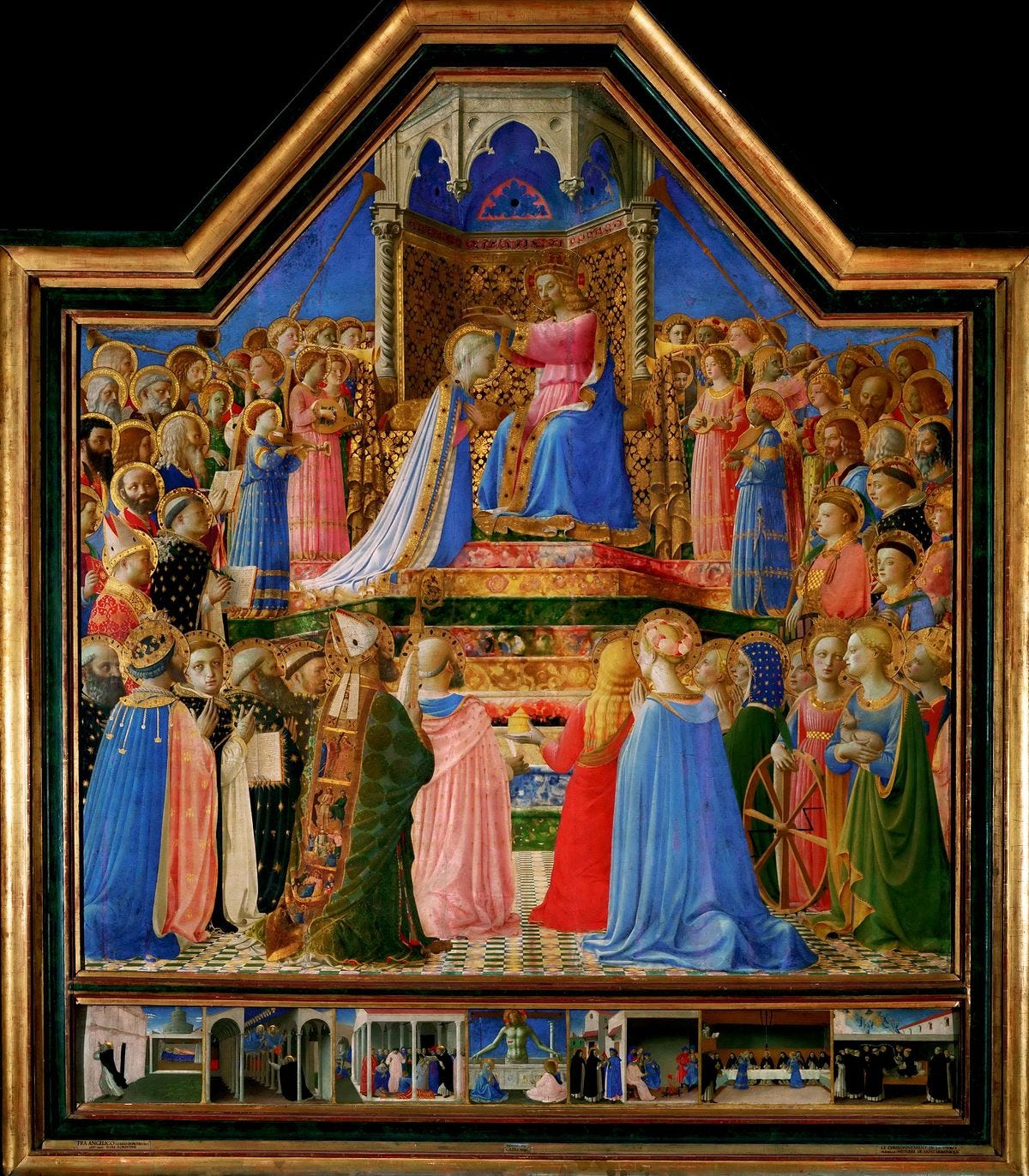
When the devout painter Guido di Pietro became a Dominican brother, he took the name “Fra Giovanni.” Today, he is known as Fra Angelico. Some say he received this title because he painted like an angel, and some say it was because he had the integrity of one, but it is hardly contested that his life and paintings reflect an angelic quality. To my knowledge, he’s the only painter who has been beatified.
Although Fra Angelico painted in the middle of the Renaissance, his paintings have a singular quality that is not totally of this period or world. He resisted naturalism to some extent and, in doing so, retained the heavenly quality of the Gothic style. John Ruskin, the famous artist and polymath, was not content with calling his works “paintings” but instead called them “visions” because of how they seemed to open up to the transcendent.
The Renaissance art historian Giorgio Vasari (1511-1574) believed the painting of Mary’s Coronation was his best:
But beyond all that Fra Giovanni ever did is a painting in the same church of the Coronation of the Virgin in the midst of a choir of angels and an infinite number of saints, which it gives one a wonderful pleasure to look at, for it seems as if blessed spirits could look no otherwise in heaven, at least if they had bodies, and they are all so lifelike and so sweet; and the whole colouring also of the work seems to be from the hand of a saint or an angel, so that it was with good reason that he was always called Fra Giovanni Angelico.
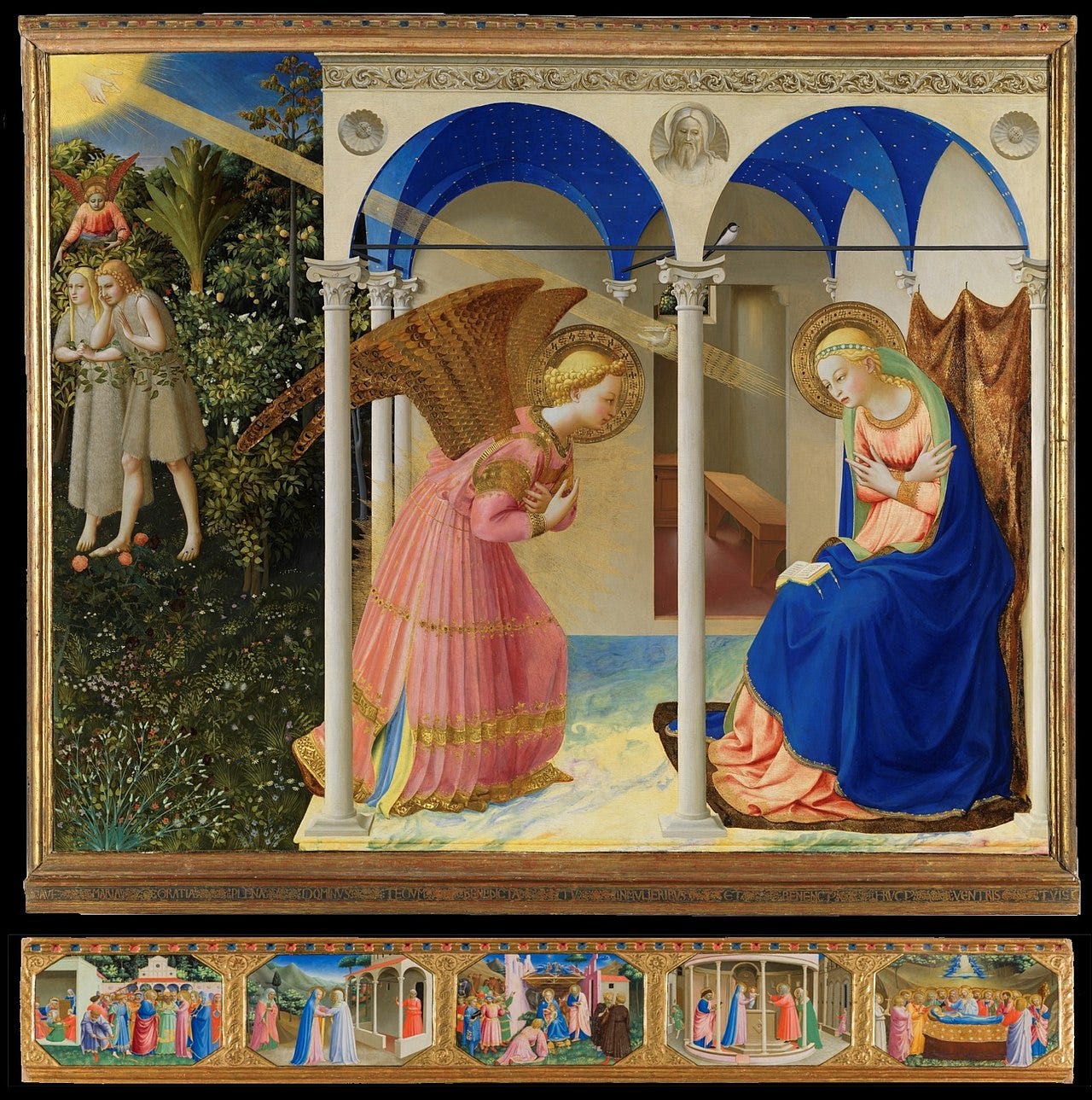
Initially, this rather large painting hung on the right of the rood screen of the Church of San Domenico in Fiesole, Italy. Fra Angelico’s famous Annunciation painting, which hangs in the Prado today, hung across from it. This fitting arrangement must have reminded congregants that Mary’s Queenship may be found in the Annunciation narrative, where the Angel tells Mary her son will be King over the house of Jacob forever. From this, many Church fathers reasoned that Mary, as the mother of the King, is a queen, as per the Davidic tradition of the Queen Mother.1
Saint John of Damascus (676-687) makes this connection in his sermon on the Annunciation:
Hail, the only Queen among queens, you who are certainly a daughter of Kings, but also the Mother of the King of universe and strength of religious kings and emperors! Hail, the only Queen among queens, covered with a gold dress and with variety, such as David, the singer of the Psalms, exclaimed!
This vision of Heaven is notably different from Botticini’s luminous dome that we reflected on last week for the Assumption. Fra Angelico sets this Coronation not in an ethereal light but on terra firma, amidst a luxurious palace. This imagery draws on the “throne” in Revelation 4 as well as other passages from Scripture—“in my father’s house there are many mansions” (John14:2) “he builds his upper rooms in the heavens” (Amos 6:9). Ornate marble steps in the painting lead to an elaborately tapestried throne covered with a delicate Gothic canopy.2 Christ sits on the throne while Mary kneels, arms folded over her chest. They both wear gilded blue and pink robes, which mark their relationship and royalty.
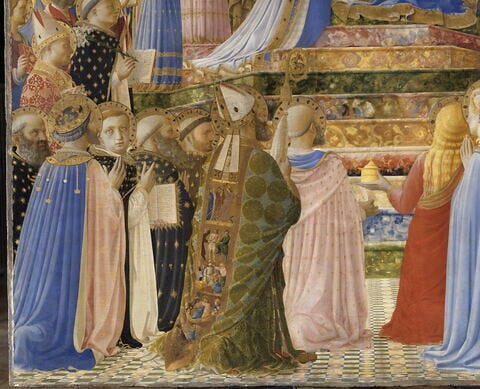
Fra Angelico alternates the colors of the steps, so your eyes have to ascend them one by one until you reach the top, where Christ places a crown on the head of his kneeling mother. This would have required kneeling viewers to look up to see Christ and Mary. The alternating of vibrant and lighter colors gives the painting the harmonious and soft quality called divine by many.
A host of saints, many of whom are recognizable—Saint Nicholas, Saint Louis, Bernard of Clairvaux, Saint Augustine, Saint Agnes, Saint Catherine, Saint Dominic, Saint Cecilia—crowd the heavenly throne while angels play trumpets and other instruments. Fra Angelico gives unique attention to each of the saints, and Saint Nicholas’s cope in particular is a remarkable detail.
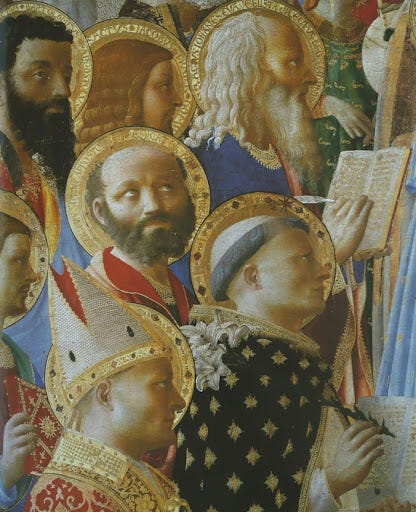
The symphony of color in the saints’ clothing matches the steps, continuously bringing us back to the stairway and then to Jesus and Mary. The centrality of the marble stairway brings attention to Mary’s title, the stairway to heaven, which was used by Saint Anselm, Archbishop of Canterbury (1033-1109):
You are the honor of the world. You the nobility of the Christian people, oh, Queen and Lady of the world. Stairway to heaven, throne of God, gate of paradise, hear the prayers of the poor, do not despise the groans of the miserable.
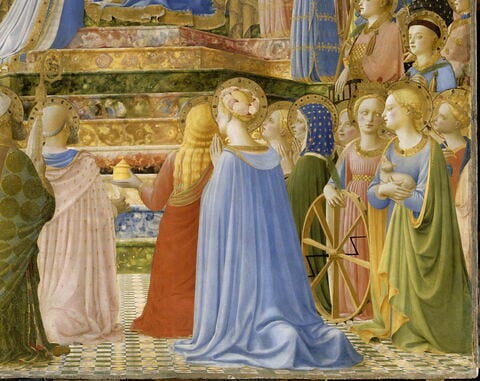
Fra Angelico’s decision to place this crowning in an architectural setting with saints also points to Mary’s architectural titles and her roles in the Church.
These titles —Ark of the Covenant, Tabernacle, Golden House, Palace, Temple, Throne of God, etc—call attention to how Mary allowed Jesus, the King of the Universe, to make his home within her womb3. Fra Angelico shows how fitting it is that Christ invites Mary—who bore him on the throne of her womb and lap—to share his throne in Heaven.
Unlike many other prominent Coronation scenes, this painting puts Christ a head above Mary and the saints, pointing to his role as Caput Ecclesia, head of the Church. The painting makes visible the fact that Mary and the saints are members of his body, with Mary as the “preeminent member.”4 Here, Mary is the Church's Queen Mother and the personification of the Church.5
As Saint Ephrem the Syrian (306-373) explains,
The Virgin Mary is a symbol of the church when she receives the first announcement of the Gospel. It is in the name of the church that Mary sees the risen Jesus. Blessed be God, who filled Mary and the church with joy. We call the church by the name of Mary, for she deserves a double name.
Renaissance churchgoers would have been familiar with this association as well as the previously mentioned Marian titles because they were commonly featured in popular Marian hymns. The instrument-playing angels by the throne of Christ probably would have prompted congregants to remember a few of these hymns. Even outside of its intended liturgical context, the painting still seems to invite us to imagine the heavenly music that would complete this jubilant scene.
De Beata Maria-10th century
You are adorned with roses and lilies, that emanate tuberose and balsam, Queen and honor of virgins, Tabernacle of Jesus Christ.6
De Sancta Maria-14th century
Illustrious advocate, Trinity’s Garden, Empress of Heaven, Deity’s Temple, star that shines very clearly in the sky, Be for me, Lady, A merciful mother.7
De Beata Maria Virgine-14th century
Hail, Queen of Glory, Mary, star of the sea, You give birth to the Sun of justice, and compare yourself to the moon [... ]
High King’s Palace, Emperor’s Throne, Bridegroom’s Kneeler, You are the spouse of the Creator.89
“In the Old Testament, under some Davidic kings, the gebirah, the "Great Lady", usually the Mother of the King, held great power as advocate with the king. Cf. 1 Kings 2:20, where Solomon said to his Mother Bathsheba, seated on a throne at his right: "Make your request, Mother, for I will not refuse you." Here is a sort of type of Our Lady.”
https://www.ewtn.com/catholicism/teachings/queen-of-heaven-and-earth-189
The canopy also recalls the ciborium, a canopy that marks the altar as the center of the Church.
https://www.catholicfidelity.com/apologetics-topics/mary/church-fathers-on-mary-as-ark-of-the-new-covenant/
This is what Von Balthasar calls her.
The clearest scriptural reference of Mary as the personification of the Church is in Revelation: “And a great portent appeared in heaven, a woman clothed with the sun, with the moon under her feet, and on her head a crown of twelve stars; she was with child and she cried out in her pangs of birth, in anguish for delivery. (Revelation 12:1-6)
For more on Mary as the personification of the Church:
Mary: The Church at the Source by Joseoh Ratzinger and Hans Urs Von Balthasar https://a.co/d/jiSD0Gq
Rosis ornata et lilio, Nardo manans et balsamo, Regina et decus virginum, Christi Jesu sacrarium.
Advocata inclita, hortus trinitatis, imperatrix coelica, templum deitatis, stella coeli fulgida summae claritatis, esto mihi, domina, mater pietatis.
Salve regina glorie, Maria stella maris, solem paris justitiae, quae lunae compararis. [... ]
“Summi regis palatium, thronus imperatoris, sponsi reclinatorium, tu sponsa creatoris.
Hymns sourced via: https://www.researchgate.net/publication/371775556_Regina_Coeli-Doctrine_and_Iconography_of_the_Virgin_Mary%27s_Heavenly_Royalty/fulltext/64944df595bbbe0c6ee9042e/Regina-Coeli-Doctrine-and-Iconography-of-the-Virgin-Marys-Heavenly-Royalty.pdf?origin=publication_detail&_tp=eyJjb250ZXh0Ijp7ImZpcnN0UGFnZSI6Il9kaXJlY3QiLCJwYWdlIjoicHVibGljYXRpb25Eb3dubG9hZCIsInByZXZpb3VzUGFnZSI6InB1YmxpY2F0aW9uIn19#page48




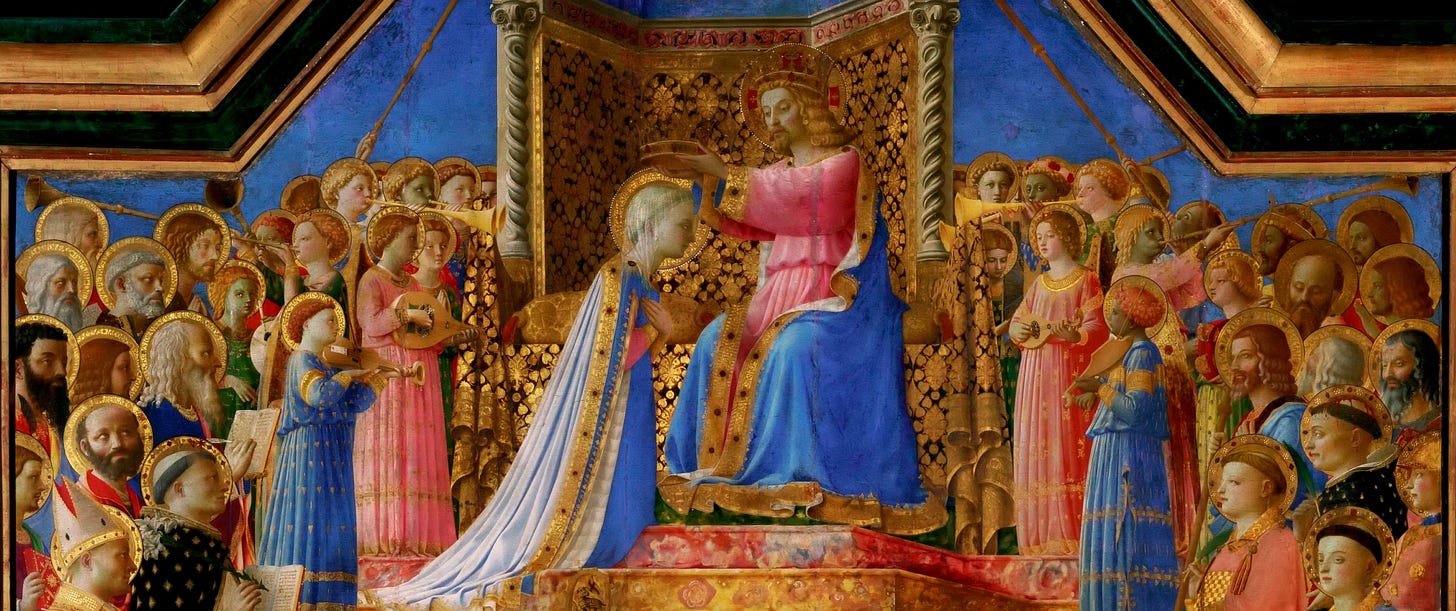
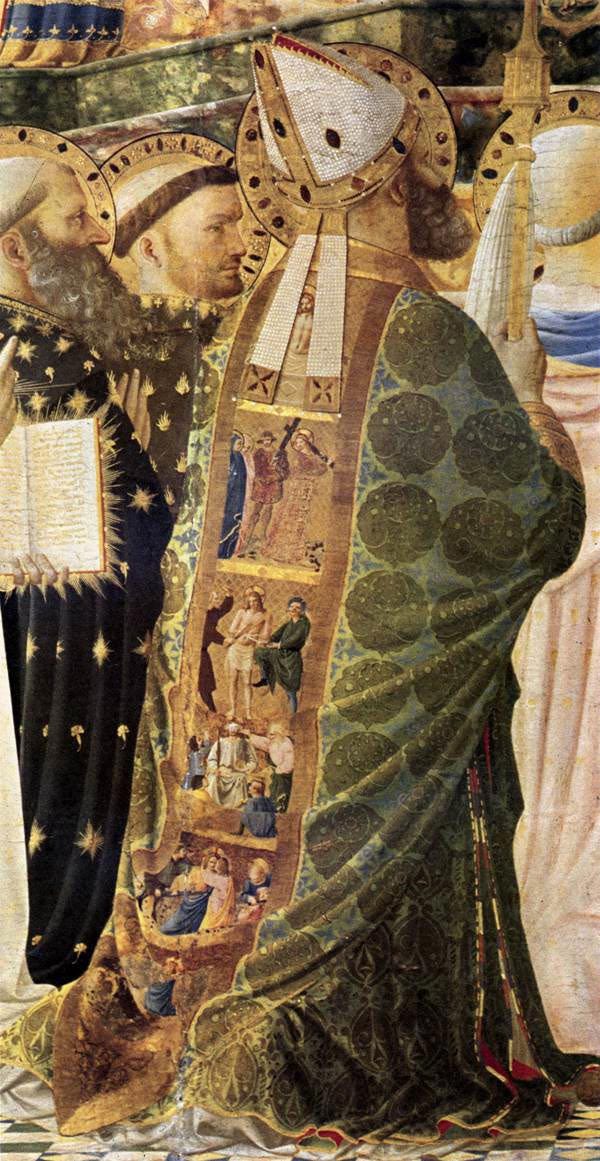
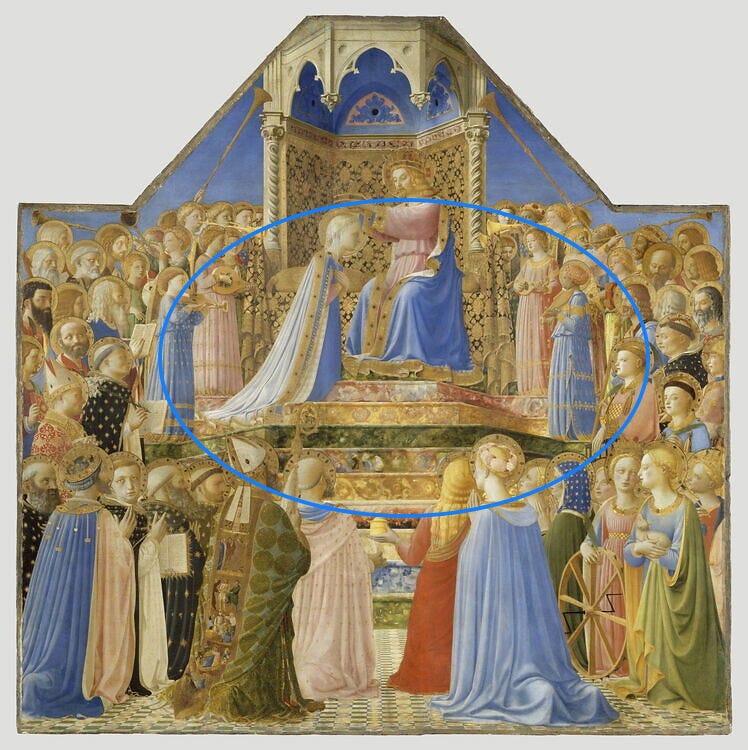
5 years ago, I was feeling desperate. I had left the world of activism because I simply couldn't stand the feeling of how useless and pointless it was to turn my mind to so much anger and evil all the time. But I didn't know what else I was supposed to do. It had been four years and I hadn't been able to settle into any other kind of work. In desperation, in October, I went down to Rome to attend a conference some former colleagues and old work friends had put together - it was the week of Pachamama - and the one thing I came away from it understanding was that "backwards" was a road that was completely irrevocably closed. But there seemed to be no "forwards" presenting itself.
I spent a week in the horrible old City, and was no further ahead, and was feeling increasingly desperate. But at one point I had walked past the old Poggi art supply shop in Trastevere, and noticed a poster in the window for an iconography course. It was already past the date, so I'd missed it. But I jotted down the name and email and sent an email off anyway. I received the expected note fairly promptly that the space for the next class was full, but she'd put my name on the list for a cancellation.
Also at some point during that dreadful week, I went into Sopra Minerva - the big Dominican church near the Pantheon where there are some glorious Lippi frescos, St. Catherine of Siena's body and general Gothic gloriousness. I stopped for a few minutes at the tomb of Fra Angelico, lit a candle and prayed for some light on my troubles.
I went back to Umbria at the end of that week, and up to Norcia to talk to Fr. Oblate Master, and he said that my feeling of very strong aversion to the thought of getting back into activism was definitely the right one, and a divine signal, not to be ignored. And anyway, he said, I was probably past the point of being capable of going back.
When I got home from all that, I checked email and found that there was a note from Sr. Susanna saying that there had been a cancellation and would I still like to come to the class? I mentioned this to a friend - for whom I'd done several favours - and the next day found a thousand dollars in my paypal with the note, "For your icon class." I was not to know it, but lockdowns were going to start about two months after I finished the course, in December 2019. It was the entire change of life-direction I'd been seeking, and at such a time! Nothing has been the same since.
Thank you for this! Fra Angelico’s Annunciation is one of my top 5 favorite works of art and I was blessed to be able to see it in person at the Prado in 2011. Now now I want to get a print of the Coronation too!